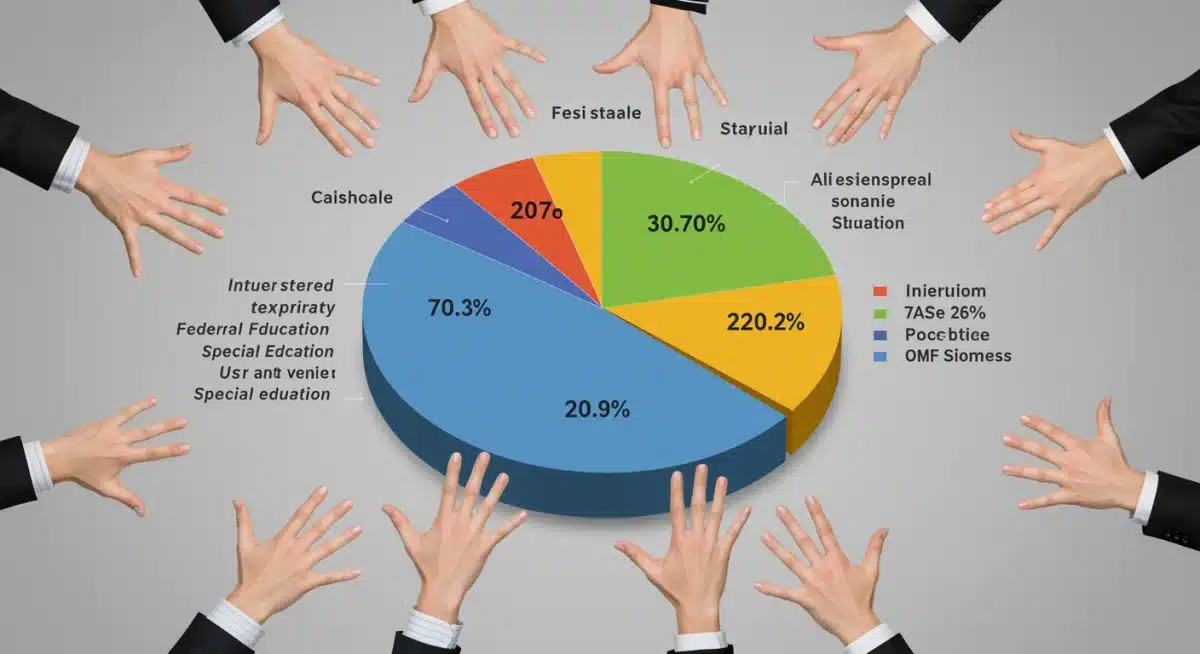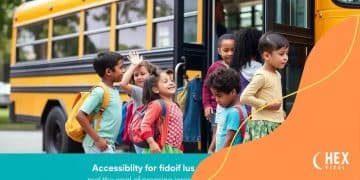Special Education Funding 2025: Trends Parents Need to Know

Understanding the current trends in U.S. special education funding for 2025 is paramount for parents and advocates to ensure students with disabilities receive equitable and necessary educational resources and support.
As we approach 2025, the landscape of special education funding 2025 in the United States continues to evolve, presenting both opportunities and challenges for students with disabilities, their families, and the educators who serve them. Navigating this intricate system requires a clear understanding of where the money comes from, how it’s allocated, and the policies driving these decisions. This comprehensive guide aims to equip parents and advocates with the essential knowledge needed to understand and influence the future of special education.
Understanding the Federal, State, and Local Funding Structure
Special education funding in the U.S. is a complex tapestry woven from federal, state, and local contributions. Each level plays a distinct role, and their interplay significantly impacts the resources available to students with individualized education programs (IEPs).
At the federal level, the Individuals with Disabilities Education Act (IDEA) mandates that states provide a free appropriate public education (FAPE) to eligible children with disabilities. While IDEA promised to fund 40% of the excess costs of educating students with disabilities, federal contributions have historically fallen short, typically covering only 13-16%.
Federal Funding and IDEA
- IDEA Part B: Provides grants to states to assist them in providing special education and related services to children aged 3 through 21. This is the largest component of federal special education funding.
- IDEA Part C: Supports early intervention services for infants and toddlers with disabilities and their families.
- Discretionary Grants: Additional federal grants for research, personnel training, and parent information centers, although these are often smaller in scale.
State governments bear a substantial portion of the financial responsibility, often through a combination of general state aid formulas and specific special education allocations. These formulas vary widely from state to state, leading to disparities in funding levels and services.
State and Local Contributions
Local school districts are typically responsible for the largest share of special education costs, drawing from local property taxes and other revenue sources. The burden on local districts is often exacerbated by the federal funding gap, forcing them to reallocate funds from general education budgets or seek additional local levies.
- Property Taxes: The primary source of local school funding, meaning wealthier districts often have more resources.
- State Equalization Aid: Some states provide additional funding to less affluent districts to promote equity.
- Categorical Aid: Specific state funds designated for special education, often based on student count or service intensity.
The intricate nature of this multi-layered funding system means that changes at any level can have ripple effects throughout the entire special education landscape. Understanding these foundational elements is the first step toward effective advocacy.
Emerging Policy Shifts and Legislative Outlook for 2025
Looking ahead to 2025, several policy shifts and legislative discussions are expected to influence special education funding 2025. These changes could impact everything from how services are delivered to the overall financial health of special education programs.
One significant area of focus is the reauthorization of IDEA. While not an annual event, discussions around its update or refinement are ongoing, particularly concerning the federal funding commitment. Advocates continue to push for increased federal contribution to meet the original 40% promise, arguing it would alleviate pressure on state and local budgets.
Potential Legislative Changes
- Increased IDEA Funding: A perennial goal for disability advocates, aiming to bridge the federal funding gap.
- Revisions to Funding Formulas: Potential adjustments at the state level to ensure more equitable distribution of resources, possibly shifting from a census-based model to one that accounts for varying levels of student need.
- Emphasis on Early Intervention: Growing recognition of the long-term benefits of early support could lead to increased funding for IDEA Part C programs.
Beyond direct funding for services, there’s a growing push for policies that support inclusive practices and address disparities. This includes funding for professional development for general education teachers to better support students with IEPs in mainstream classrooms, as well as initiatives to reduce disproportionate representation of certain demographic groups in special education.
Technological advancements also play a role. Policymakers are exploring how funding can support assistive technology and digital learning tools, recognizing their potential to enhance educational access and outcomes for students with disabilities. However, ensuring equitable access to these technologies, especially in under-resourced areas, remains a challenge that funding policies must address.
The legislative outlook for 2025 suggests a continued debate over the balance of federal, state, and local responsibilities, with a constant push from advocacy groups to prioritize the needs of students with disabilities through more robust and equitable funding mechanisms.


Impact of Economic Climate on Special Education Budgets
The broader economic climate invariably influences special education budgets. Economic downturns often lead to cuts in state and local revenues, which in turn can reduce funds available for education, including special education services. Conversely, periods of economic growth may present opportunities for increased investment.
For 2025, economic forecasts will be closely watched. Inflationary pressures can erode the purchasing power of existing budgets, making it more expensive to provide the same level of services. This is particularly critical for special education, which often involves specialized personnel, equipment, and therapies that are costly.
Inflationary Pressures and Resource Allocation
- Increased Costs for Services: Higher prices for specialized therapies, transportation, and assistive technology.
- Personnel Shortages: Competitive salaries needed to attract and retain highly qualified special education teachers and related service providers.
- Budget Reallocation: Districts may be forced to make difficult decisions about reallocating funds, potentially impacting program quality.
The post-pandemic economic recovery also brings its own set of challenges and opportunities. While federal relief funds provided a temporary boost, their expiration could leave gaps that state and local budgets struggle to fill. This makes the sustainability of funding a significant concern for special education programs.
Moreover, demographic shifts, such as an increase in the number of students identified with disabilities or a rise in complex needs, can place additional strain on budgets. Without corresponding increases in funding, districts may find it difficult to meet the individualized needs of all students.
In conclusion, the economic climate directly dictates the capacity of governments to fund special education. Parents and advocates need to be aware of these economic realities and how they might influence budget decisions, ensuring they can effectively argue for the continued support of essential services.
Key Advocacy Strategies for Parents and Guardians
For parents and guardians, active advocacy is crucial in shaping the future of special education funding 2025 and ensuring their children receive the services they need. Understanding the funding landscape is just the first step; effective engagement requires strategic action.
Start by becoming an expert on your child’s IEP and the services they are entitled to. Document all communications and ensure that the IEP is being fully implemented. If services are being cut or reduced, understand the reasons and challenge them if necessary.
Empowering Advocacy Actions
- Stay Informed: Regularly follow legislative updates at federal, state, and local levels regarding education and special education funding.
- Engage with School Boards: Attend meetings, speak during public comment periods, and communicate directly with board members about the importance of special education funding.
- Contact Legislators: Write letters, send emails, or call your elected officials to share your personal story and advocate for increased special education appropriations.
- Join Advocacy Groups: Connect with local and national organizations dedicated to disability rights and special education. These groups often have organized advocacy efforts and can provide valuable resources and support.
Coalition building is also a powerful strategy. By collaborating with other parents, educators, and community members, advocates can amplify their voices and exert greater influence on policy decisions. Sharing personal stories about the impact of special education services (or the lack thereof) can be particularly compelling to policymakers.
Another critical aspect is understanding the budget process at the local school district level. Knowing when budget decisions are made and how to provide input can make a significant difference. Don’t be afraid to ask questions about how funds are allocated and what specific programs are supported.
Ultimately, effective advocacy means being persistent, informed, and collaborative. By actively participating in discussions and decision-making processes, parents and guardians can play a vital role in securing adequate and equitable funding for special education.
The Role of Technology and Innovation in Service Delivery
Technology and innovation are increasingly playing a transformative role in special education service delivery, offering new avenues for learning and support. As we look towards 2025, funding decisions will need to reflect the growing importance of these tools.
Assistive technology (AT) ranges from simple tools like pencil grips to complex communication devices and specialized software. When adequately funded, AT can significantly enhance a student’s ability to access the curriculum, communicate, and participate in school activities. However, the cost of these technologies and the training required to use them effectively can be substantial.
Innovations Shaping Special Education
- Assistive Technology (AT): Devices and software that help students with disabilities access education and daily living. Funding needs to cover procurement, maintenance, and training.
- Telehealth and Remote Services: The expansion of remote therapy and educational support, particularly for students in rural areas or those with specific health needs.
- Personalized Learning Platforms: AI-driven tools that adapt to individual student learning styles and paces, offering tailored instruction.
- Virtual Reality (VR) and Augmented Reality (AR): Emerging technologies that can create immersive learning experiences and simulations for skill development.
Remote learning and telehealth services, accelerated by recent global events, have proven to be invaluable for many students with disabilities. Funding models for 2025 will likely need to integrate support for these modalities, ensuring that all students, regardless of their location, can access necessary therapies and instruction.
Furthermore, data analytics and artificial intelligence (AI) offer potential for more personalized learning experiences and early identification of student needs. While these technologies hold promise, funding must also address concerns about data privacy, equitable access, and the professional development required for educators to effectively integrate them into their practice.
The integration of technology and innovation into special education is not merely about adopting new gadgets; it’s about reimagining how services are delivered to maximize student potential. Adequate funding is essential to ensure these advancements are accessible and effectively utilized across all school districts, bridging the digital divide.
Addressing Disparities and Promoting Equity in Funding
A persistent challenge in special education funding 2025 is the issue of disparities and the need to promote greater equity. Funding inequities often disproportionately affect marginalized communities, leading to significant gaps in services and outcomes for students with disabilities from low-income backgrounds or specific racial and ethnic groups.
One major disparity stems from the reliance on local property taxes for school funding. Wealthier districts, with higher property values, can generate more revenue, providing better-funded special education programs. Conversely, districts in economically disadvantaged areas struggle to adequately fund services, despite often having a higher proportion of students with intensive needs.
Key Areas for Equity Focus
- Funding Formulas: Re-evaluating state funding formulas to ensure they adequately account for the higher costs associated with educating students with more significant disabilities and those from low-income families.
- Resource Allocation: Directing additional resources to districts with high concentrations of poverty or historically underserved populations.
- Teacher Retention: Providing incentives and support to attract and retain highly qualified special education teachers in high-need areas.
- Cultural Competency Training: Funding professional development to ensure educators are equipped to address the diverse linguistic and cultural needs of students with disabilities.
Disproportionate representation in special education is another equity concern. Certain racial and ethnic minority groups are often over-identified for special education services, while others are under-identified, suggesting biases in identification processes. Funding initiatives should support efforts to address these biases and ensure appropriate identification and service delivery.
Advocacy for equity also involves pushing for transparency in how funds are allocated and spent. Parents and community members need clear information to hold districts accountable for equitable resource distribution and to identify areas where disparities persist. Policies promoting equitable funding are not just about fairness; they are about ensuring every student with a disability has an equal opportunity to succeed.
Future Outlook: Sustainable Funding Models and Collaboration
The future outlook for special education funding 2025 hinges on developing more sustainable funding models and fostering greater collaboration among all stakeholders. The current system, with its reliance on fluctuating federal contributions and varied state and local efforts, often leads to instability.
Sustainable funding models would involve a more consistent and adequate federal commitment to IDEA, reducing the burden on state and local governments. This would allow for better long-term planning and investment in programs and services, rather than reacting to annual budget shortfalls.
Components of Sustainable Funding
- Increased Federal Share: A consistent increase in federal funding to meet or approach the 40% IDEA mandate.
- State-Level Stability: Development of state funding formulas that are less susceptible to economic fluctuations and prioritize special education needs.
- Innovative Local Solutions: Exploring local partnerships, grants, and community-based funding initiatives to supplement traditional revenue streams.
Collaboration is equally vital. This includes improved communication and partnership between federal, state, and local education agencies, as well as stronger alliances between school districts, parents, advocacy groups, and community organizations. When all stakeholders work together, they can collectively identify needs, share resources, and advocate for more effective policies.
Furthermore, investing in preventative measures and early intervention programs can lead to long-term cost savings and improved outcomes. By providing support at earlier stages, some students may require less intensive, and therefore less costly, services later in their educational journey. Funding models should reflect this understanding.
The future also demands a focus on accountability. Funding should be tied to measurable outcomes for students with disabilities, ensuring that resources are being used effectively to improve academic achievement, social-emotional development, and post-school success. This holistic approach to funding and collaboration is essential for building a robust and equitable special education system for 2025 and beyond.
| Key Trend | Brief Description |
|---|---|
| Federal Funding Gap | IDEA’s 40% promise remains unmet, shifting burden to states and local districts. |
| Economic Impact | Inflation and post-pandemic recovery influence budget allocations and service costs. |
| Technological Integration | Increasing reliance on assistive technology and remote services requires dedicated funding. |
| Equity & Disparities | Addressing unequal resource distribution, especially in underserved communities. |
Frequently Asked Questions About Special Education Funding
The primary source of special education funding comes from a combination of federal, state, and local governments. While the federal Individuals with Disabilities Education Act (IDEA) provides some funding, state and local contributions, often from property taxes, bear the largest financial responsibility for special education services.
The federal government contributes through IDEA Part B grants for children aged 3-21 and Part C for early intervention. Historically, federal funding has covered only 13-16% of the excess costs, despite a promised 40%, leaving a significant gap for states and local districts to fill.
Economic conditions significantly impact special education budgets. Downturns can lead to reduced state and local revenues, forcing budget cuts. Inflation can also erode purchasing power, increasing the cost of specialized services, equipment, and competitive salaries needed to attract qualified personnel.
Parents can advocate by staying informed about legislative changes, engaging with school boards, contacting elected officials to share personal stories, and joining local or national advocacy groups. Understanding their child’s IEP and documenting service implementation are also crucial steps in effective advocacy.
Technology plays an increasingly vital role, with assistive technology, telehealth, and personalized learning platforms enhancing access and outcomes. Funding in 2025 will need to support the procurement of these tools, professional development for educators, and ensure equitable access across all school districts to bridge the digital divide.
Conclusion
The current trends in U.S. special education funding 2025 underscore a critical need for continued vigilance and proactive engagement from parents, advocates, and policymakers alike. While challenges persist, particularly concerning the federal funding gap and economic pressures, there are also opportunities through policy shifts, technological advancements, and collaborative efforts. By staying informed, advocating strategically, and working together, we can strive towards a future where all students with disabilities receive the equitable and high-quality education they deserve, ensuring their full participation and success in society.






